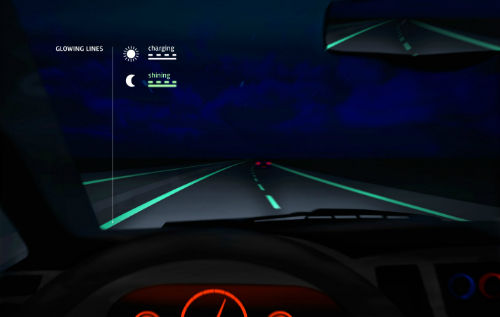A 500 meter (approximately .3 miles) section of a highway in the Netherlands is getting its glow on. Glow in the dark road markings — made with a photoluminescent powder incorporated into road paint that charges in the light and radiates green in the dark for up to eight hours — have been painted on the road, reports the BBC. The glowing designations, which are currently part of a trial, render streetlights unnecessary.

Glowing highway center lines. From Studio Roosegaarde.
A collaboration between artist Daan Roosegaarde and the Dutch civil engineering firm Heijmans that began over two years ago, the glow in the dark technology will be officially launched later this month. Those in the Netherlands can view the current test run on highway N329 in Oss, which is about 62 miles southeast of Amsterdam. This project is the first to test “glowing lines” technology on the streets.
Artist Roosegaard, who previously designed a dance floor with lights controlled by dancers’ moving feet, told the BBC last year that “The government is shutting down streetlights at night to save money, energy is becoming much more important than we could have imagined 50 years ago. This road is about safety and envisaging a more self-sustainable and more interactive world.”
“I was completely amazed that we somehow spend billions on the design and R&D of cars but somehow the roads — which actually determine the way our landscape looks — are completely immune to that process,” Roosegaarde said.
Engineering firm Heijmans had already been working on “energy-neutral” streetlights when Roosegaarde signed on. His inspiration came, at least in part, from the sea: “I thought that was updating an old idea, and I forced them to look at movies of jellyfish. How does a jellyfish give light? It has no solar panel, it has no energy bill. And then we went back to the drawing board and came up with these paints which charge up in the daytime and give light at night,” he said.
In addition to conserving energy and funds, energy-neutral street lighting is also important, according to Heijmans, as “a sustainable alternative to places where no conventional lighting is present.”
The original collaboration, known as Smart Highways, also included temperature-sensitive weather markings, such as snowflakes that would appear when the thermometer reached a certain point, and wind-powered streetlamps, but currently this phase of the project includes only the glow in the dark markings.
Cost-effective street lighting as a concept isn’t new — reflectivity, which we’ve reported on this very blog, has been used for 75 years. Yet, as NPR reports, there are bureaucratic barriers to glow in the dark technology. Emina Sendijarevic, of Studio Roosegaarde, explains: “Research on smart transportation systems and smart roads has existed for over 30 years — call any transportation and infrastructure specialist and you’ll find out yourself… What’s lacking is the implementation of those innovations and making those innovations intuitive and valuable to the end-consumers: drivers.”
Other obstacles to the project being adapted elsewhere include: testing skid resistance, measuring how far the glow in the dark markubgss can be viewed, measuring visibility during the daytime, and testing wintertime performance, the UK Highways Agency told the BBC.